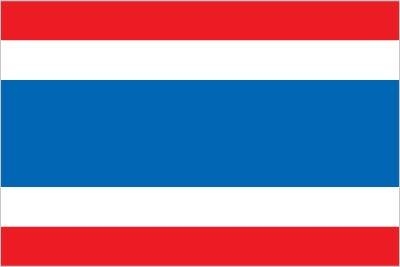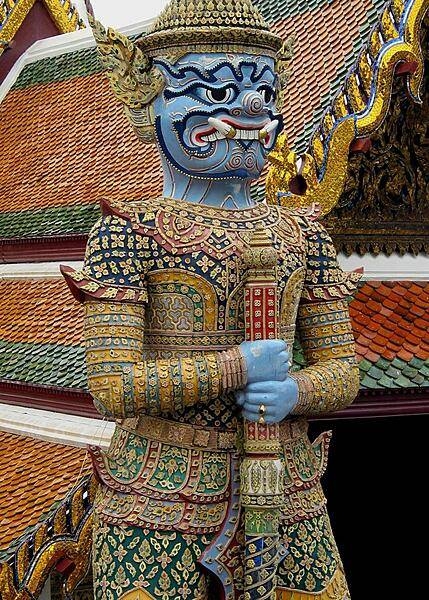169 Thailand

Five horizontal bands of red (top), white, blue (double width), white, and red. The red color symbolizes the nation and the blood of life, white represents religion and the purity of Buddhism, and blue stands for the monarchy.
Flag courtesy of the CIA World Factbook

Map courtesy of the CIA World Factbook

A Yaksha demon guards the Wat Phra Kaew (Temple of the Emerald Buddha) in the Grand Palace in Bangkok.
Photo courtesy of the CIA World Factbook
Government
According to Britannica, Thailand is a constitutional monarchy with the monarch as the head of state. While almost every government since 1932 has accepted constitutional authority, the country has had 17 constitutions, the most recent drafted in 2007. All of these documents have provided for a National Assembly with a prime minister as head of government. Power is exercised by the bicameral National Assembly, the Council of Ministers, and the courts in accordance with the provisions of the constitution and laws passed by the National Assembly. The constitution of 2007 (largely based on that of 1997) provides for the direct election of members of the lower house of the Assembly, the House of Representatives, to four-year terms, five-sixths from single-member districts and the remainder based on proportional representation from the political parties. It also requires the prime minister to be a member of the House of Representatives. Members of the upper house, the Senate, are directly elected to six-year terms. Legislation originates in the House of Representatives, but it can be modified or rejected by the Senate.
In May 2014, following a military coup, the 2007 constitution was suspended (except provisions pertaining to the monarchy), and a council of military leaders took power. That council appointed a 200-member single-chamber interim legislature in late July. The leader of the council was named interim prime minister in late August.
The execution of laws is carried out by the civil service, whose members are known as kharatchakan, “servants of the king.” The bureaucracy, particularly the Ministry of Interior, has always enjoyed a significant degree of autonomy in administering the country. The number of elective offices and senior civil-service positions occupied by women is small, though increasing slowly.
For most people in Thailand, government is experienced primarily through centrally appointed officials who hold posts in local administration, the main units of which are provinces (changwat) and districts (amphur). In the 1990s three new provinces were carved out of the existing ones, resulting in a total of 76.
A marked devolution of power has taken place since the 1980s. By far the most significant of the local governing bodies are those in the major cities, including Bangkok, Chiang Mai, and Pattaya. Locally elected provincial assemblies have little power, but they serve as incubators for local politicians who may later be elected to the National Assembly. In 1997, communes (tambon), units consisting of several villages, were given increased powers and the authorization to elect members of tambon administrative organizations. With new administrative and financial authority, these bodies have become the most important local democratic units in Thailand. Headmen of villages (muban) are also elected, but their authority is circumscribed by centrally appointed district officers and the tambon administrative organizations.
Thailand had a sophisticated legal system before Western influences led it to adopt a system of jurisprudence based on European models. The first law codes—dating from as early as the 15th century—were based on the Indian code of Manu, which arrived by way of the Mon and the Khmer. As part of the modernizing reforms of the late 19th century, a new legal system was developed, based primarily on the French (Napoleonic) model. The modernizing government of King Chulalongkorn also received legal advice from British advisers. A significant aspect of the legal reforms of the late 19th century was the creation of an independent judiciary. This ideal proved difficult to realize, however, because of interference by politicians and the continuing presence of corruption within the system. As part of a series of judicial reforms initiated at the end of the 20th century, the Supreme Court, with justices appointed by the monarch, was declared the final court of appeal for both civil and criminal cases; a system of intermediary appeals courts was established to handle cases from courts of first instance scattered throughout the country.
Civil Aviation Authority of Thailand (CAA)
The Civil Aviation Authority (CAA) of Thailand, is an independent agency of the Thai government under the oversight of the Minister of Transport. Its responsibilities includes prescribing, regulating, and auditing Thai civil aviation.
Airspace
SkyVector – Google Maps – ADS-B Exchange
ICAO countries publish an Aeronautical Information Publication (AIP). This document is divided into three parts: General (GEN), En Route (ENR) and Aerodromes (AD). ENR 1.4 details the types of airspace classes they chose to adopt from classes A through G.
Drone Regulations
Important Things to Know Before Flying a Drone in Thailand
Planning to fly a drone in Thailand ? Here’s how to prepare for a smooth flight
How to Display Your Drone Registration Number
Remotely Piloted Aircraft (RPA) Regulation
Announcement of the Ministry of Transport
Advanced Air Mobility (AAM) Regulations & Policies
Advanced Air Mobility (AAM) News
2025 – EHang demos eVTOL as part of Thailand regulatory initiative
2025 – Drone boom takes off in Thailand with Air Taxi on the horizon
2025 – SkyDrive, partners to advance eVTOL operations in Thailand
2025
Video courtesy of Advanced Air Mobility Institute from the July 2025 Global AAM Forum.
2025 – Pan Pacific orders 500 eVTOL aircraft from Chinese start-up
2025
Video courtesy of Advanced Air Mobility Institute from the January 2025 Global AAM Forum. Complete session for Day 1 of this Forum is available on the Advanced Air Mobility Institute YouTube Channel
2024 – Debut Passenger Flights Completed by Pilotless eVTOL
2024 – EHang conducts initial EH216-S passenger flights in Thailand
2024 – SkyDrive signs MoU to explore new business options for eVTOLs in Thailand
Short Essay Questions
Scenario-Based Question
You have been hired by a Drone Startup Company. Your boss has immediately assigned this job to you.
They need you to prepare a one-page memo detailing the legalities of using a drone to film the Grand Palace in Bangkok, pictured above.
They need you to mention any national laws and local ordinances.
They specifically want to know what airspace (insert pictures) you will be operating in and whether or not you need an airspace authorization.
Does it matter whether or not you are a citizen of the country?
Lastly, there is a bonus for you if, as you scroll through this chapter, you find any typos or broken links!
Short Essay Questions
- What are the drone categories?
- How is registration addressed?
- How is remote ID addressed?
- What are the model aircraft rules?
- What are the commercial drone rules?
- Are there waivers or exemptions to the rules? If so, for what?
- Would you share a link to an interactive airspace map?
- How is BVLOS addressed?
- How can you fly drones at night?
- How can you fly drones over people?
- Where do you find drone NOTAMs?
- What are the rules for drone maintenance?
- What are the rules for an SMS program?
- What are some unique rules not mentioned above?
- What are the C-UAS rules?
- What are the AAM rules?

